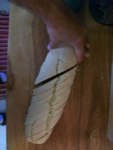You are currently browsing the tag archive for the ‘anise’ tag.
A few times a year I try to prepare recipes that I have never previously attempted in my life – sometimes because I lacked certain equipment, or ingredients, or nerve. Yes, I have been intimidated by everything from Chopped Liver to Paella, MaPoDofu to Pheasant Wellington.
I found a gorgeous Paellera (a paella pan) at a church basement sale 2 days ago, and as I work up the courage to make paella in the near future, I decided to rev-up my engine by making Bouillabaisse for the first time. I don’t know why I waited this long.
 This recipe is adapted from the New York Times International Cookbook, which was gifted to me by a friend many years ago. As I started fishing around for recipes (no pun intended) I finally settled on this recipe source, and incorporated parts of Bouillabaisse I & Bouillabaisse II. I didn’t have any clams or mussels; however, I did have about a pound of good frozen cod, so I used that as well as some cooked and peeled frozen shrimp as a starting point.
This recipe is adapted from the New York Times International Cookbook, which was gifted to me by a friend many years ago. As I started fishing around for recipes (no pun intended) I finally settled on this recipe source, and incorporated parts of Bouillabaisse I & Bouillabaisse II. I didn’t have any clams or mussels; however, I did have about a pound of good frozen cod, so I used that as well as some cooked and peeled frozen shrimp as a starting point.
I will record the version I adapted, but it is important to look at the original recipes, because they represent authentic approaches. My attempt is a home-cook’s improvisation with ingredients at hand.
1 to 1-1/2# striped bass, black bass or other white, flesh,non-oily fish, about one & a half inch thick steaks
2 T olive oil
1 T butter
1 large onion, chopped (about 2 c)
1 large stalk celery, chopped
1 bay laurel leaf, dried or fresh
1 generous tsp saffron
salt & freshly ground pepper
1 cup tomato puree, plus 1 more generous cup or so of tomato pulp
generous pinch of dried thyme, or slightly more if it is fresh
1 big clove minced garlic
Tabasco sauce, several good strong dashes will do
4 c good fish stock (it can be found in some supermarkets, or you can make it w very little trouble, using fish bones, shrimp shells, etc)
about 18 shrimp (I used a 70-90 count/pound)
big pinch of anise seed, finely ground to dust
2-3 T chopped parsley
Over medium heat add the olive oil & butter to a deep, heavy vessel, adding onion, celery, garlic, salt, pepper, ground anise seed,and crumble the saffron well into the mix. Bring to a boil, adding 1 cup of tomato, thyme and Tabasco. I didn’t have fresh tomatoes, but I did have some very good home-canned tomatoes, so I used that – you will be using at least 2, and perhaps almost 3 cups of tomato in total. Allow everything to simmer for 1/2 hour, after adding the fish stock, and reducing the heat to low.
After this has had a chance to mingle and the fragrances marry, and your kitchen starts to smell really good, lay your fish over the stew, cover and continue to cook gently for another 8-10 minutes.
About 5 minutes from the end of cooking add your shrimp (or other shellfish, and cook according to convention, which would otherwise be about 10 minutes)
Follow by strewing in chopped parsley, and gently incorporating, using the spoon to separate and flake the cooked fish into generous pieces that will fit onto a spoon. If you use white wine (that would probably be about 1/2 c) and Pernod (an anise flavored liqueur- probably a Tbsp) you could add these during cooking.
]
Serve with croutons – or as I did with hot buttered toast, from homemade bread. This may not be the most faithful rendition of bouillabaisse evar, but making this helped me lose my fear of making it again.
A world famous dish can be created in your kitchen, and the grocery bill doesn’t have to be huge. I took short cuts, but if you can lay hands on some clams, lobster or mussels – they would go in the pot, too. The only really costly item is saffron, and there aren’t much ways around that. It’s an overarching characteristic of the dish, in color & flavor. You can almost eat bouillabaisse just by breathing it in.







